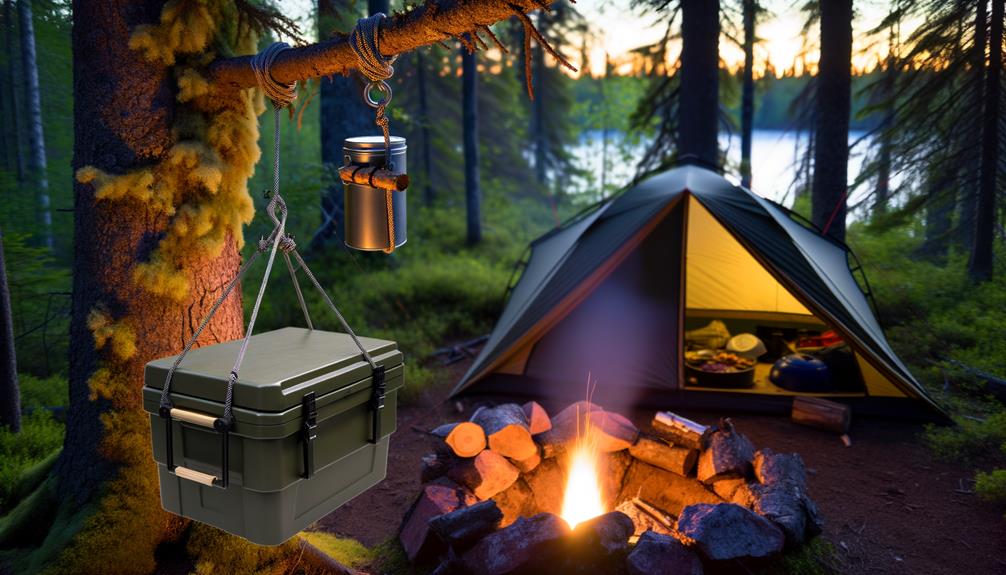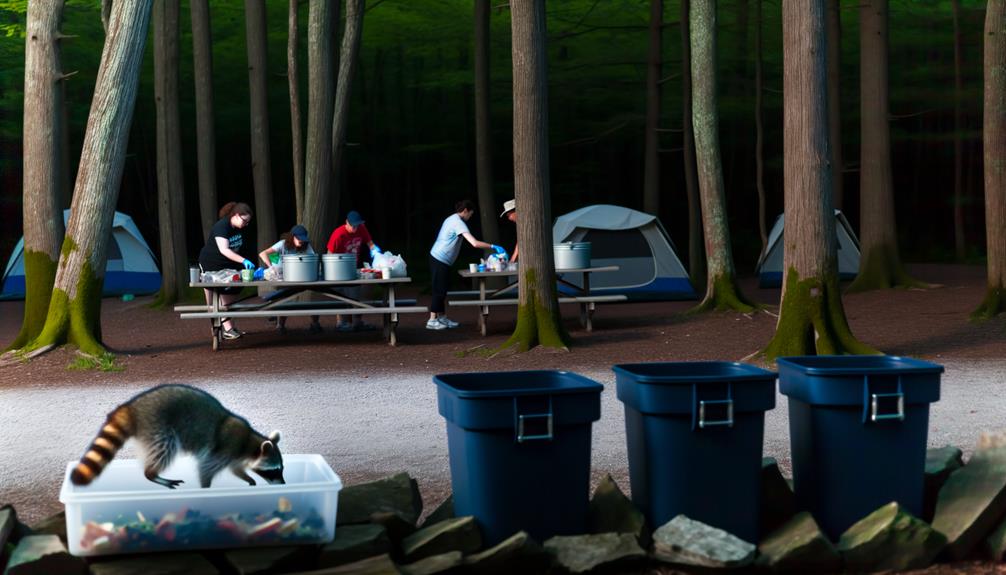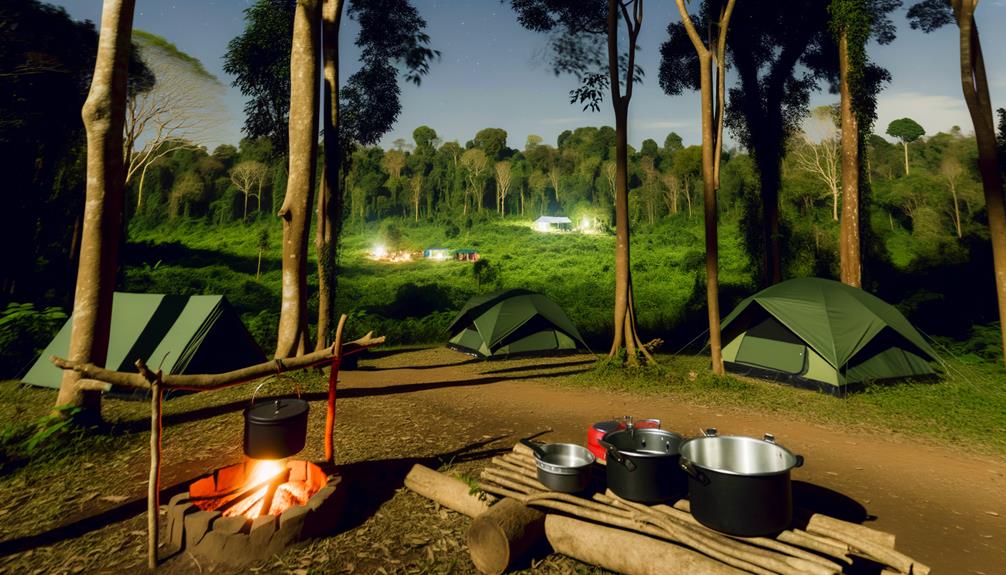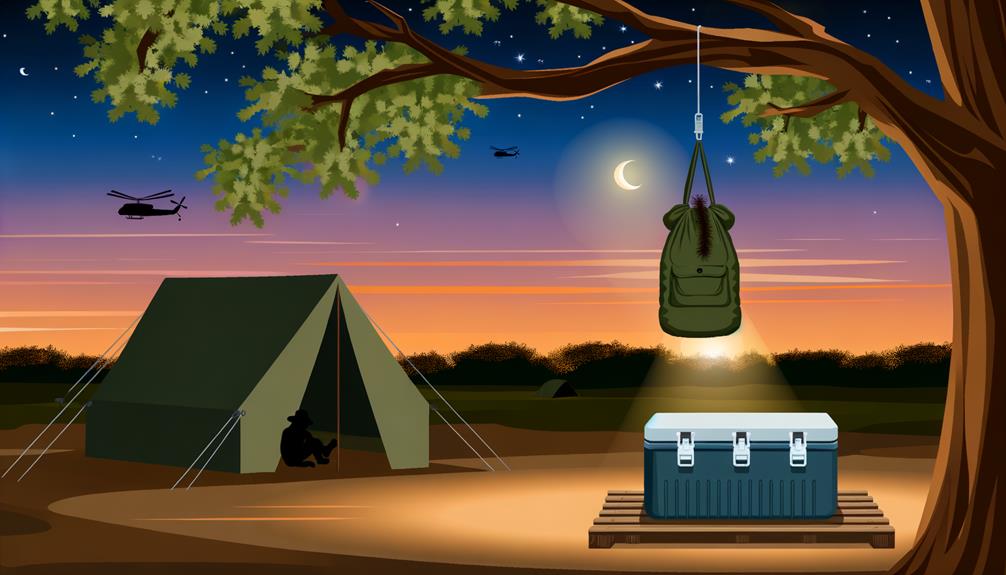5 Essential Tips Campers Use to Protect Their Food from Raccoons
To protect food from raccoons, campers should use bear-proof containers and locking coolers with robust latches. Suspending food at least 10-12 feet above ground in trees can disrupt raccoons' climbing capabilities.
Storing food in car trunks is effective due to reduced accessibility and olfactory insulation. Prompt trash disposal in sealed, raccoon-proof containers is critical, as is placing food storage at least 100 yards downwind from sleeping areas.
Utilizing scent-resistant bags with advanced materials and proper sealing techniques notably minimizes odor leakage. For further measures to safeguard your food, explore more detailed methods and the science behind them.

Key Takeaways
- Use bear-proof containers and locking coolers to prevent raccoons from accessing food.
- Hang food at least 10-12 feet above ground using durable rope and secure knots.
- Store food in car trunks to minimize scent and reduce entry points.
- Dispose of trash promptly in sealed, raccoon-proof containers and transport waste to designated sites regularly.
- Install motion-activated lights to startle and deter raccoons from food storage areas.
Store Food in Bear-Proof Containers

Utilizing bear-proof containers is an effective and scientifically validated method to safeguard food from raccoon interference. These containers, originally designed to withstand the strength and dexterity of bears, also prevent raccoons from accessing stored food.
The construction involves durable, high-density polyethylene or metal, which raccoons cannot chew through or manipulate. Research indicates that bear-proof containers reduce wildlife encounters by over 90%, thereby minimizing the risk of disease transmission and property damage.
Additionally, their secure locking mechanisms deter raccoons, known for their problem-solving abilities. By restricting food access, these containers help maintain ecological balance by discouraging raccoons from becoming habituated to human food sources.
This method is a cornerstone of effective camp food management, ensuring both safety and environmental conservation.
Use Locking Coolers
Locking coolers, designed with advanced security features, offer a robust solution for preventing raccoons from accessing stored food. These coolers utilize reinforced latches, heavy-duty construction materials, and intricate locking mechanisms to thwart the dexterous paws of raccoons.
Scientific studies have demonstrated that raccoons possess problem-solving abilities, making traditional coolers inadequate. Locking coolers mitigate this risk through precision engineering, ensuring the integrity of stored food. The materials used are often resistant to chewing and clawing, providing an additional layer of defense.
When selecting a locking cooler, campers should consider models tested for wildlife resistance, as these have undergone rigorous evaluation to confirm their effectiveness. Employing locking coolers is a critical step in safeguarding provisions from raccoon interference.
Hang Food in Trees

In addition to employing locking coolers, another effective method to prevent raccoons from accessing food is to hang provisions in trees at a sufficient height and distance from the trunk. This technique disrupts the raccoon's ability to climb directly to the food source.
Scientific guidelines suggest suspending the food at least 10-12 feet above ground and 4-6 feet away from the tree trunk. Utilizing a durable rope and a secure knot, such as a clove hitch, can further guarantee the stability of the setup.
Empirical evidence indicates that raccoons, despite their agility, struggle to navigate these hanging obstacles. This method not only deters raccoons but also minimizes the risk of food contamination, promoting a safer camping environment.
Keep Food in Car Trunks
Securing food in car trunks presents a scientifically proven method to thwart raccoons, leveraging the vehicle's robust barrier to protect provisions from these persistent foragers.
Raccoons possess notable dexterity and problem-solving skills, enabling them to access inadequately secured food sources. However, the structural integrity and complexity of car trunks present a formidable challenge for these animals.
Empirical studies indicate that using a car's trunk notably reduces the likelihood of food theft by raccoons due to the lack of accessible entry points and the impermeability of automotive materials.
Additionally, the olfactory insulation provided by the trunk minimizes the food scent, further deterring raccoon interest. This method is both practical and effective, ensuring campers' provisions remain secure from nocturnal marauders.
Clean Up Immediately

To mitigate the risk of attracting raccoons, it is essential to dispose of trash promptly and clean cooking utensils thoroughly. Any residual food particles or odors can act as powerful attractants for these opportunistic feeders.
Additionally, storing food securely in airtight containers or other raccoon-proof storage solutions further reduces the likelihood of raccoon incursions.
Dispose of Trash Promptly
Prompt and thorough disposal of trash is a critical measure in mitigating the risk of raccoon intrusion and contamination. Raccoons possess highly developed olfactory senses, enabling them to detect food residues from considerable distances.
Immediate removal of waste eliminates attractants, thereby reducing the likelihood of raccoon encounters. Employing sealed, raccoon-proof containers for trash is advisable, as these prevent access and further deter these opportunistic feeders.
Additionally, campers should regularly transport waste to designated disposal sites, ensuring it does not accumulate at the campsite. By adhering to these protocols, campers can maintain a more hygienic environment, ultimately safeguarding their provisions from raccoon-related disturbances.
This systematic approach is essential for minimizing the risk of food contamination and preserving campsite integrity.
Clean Cooking Utensils Thoroughly
In addition to proper waste disposal, meticulously cleaning cooking utensils immediately after use is vital in preventing raccoon attraction. Residual food particles and grease left on utensils can emit strong odors detectable by raccoons, whose sense of smell is highly sensitive. Immediate cleaning minimizes these olfactory cues, thereby reducing the likelihood of raccoons being drawn to the campsite.
Employing biodegradable soap and hot water guarantees thorough removal of food residues and minimizes environmental impact. Furthermore, drying utensils completely before storage is essential, as damp utensils can harbor bacterial growth, further attracting wildlife.
Campers should establish a routine of cleaning and drying utensils in a designated area away from sleeping quarters to maintain a hygienic and raccoon-free environment.
Store Food Securely
Ensuring the secure storage of food is crucial in deterring raccoons, as these animals possess adept problem-solving skills and can easily access improperly stored provisions. To mitigate this risk, campers should utilize bear-resistant containers or heavy-duty coolers equipped with locking mechanisms.
In addition, suspending food supplies from a tree branch, at least 12 feet off the ground and 6 feet from the trunk, can provide an effective deterrent. It is imperative to store food promptly after meals and to clean up all food residues immediately to avoid attracting raccoons.
Furthermore, storing food and scented items, such as toiletries, away from sleeping areas reduces the likelihood of raccoon encounters. By implementing these measures, campers can significantly reduce food theft and potential wildlife conflict.
Use Odor-Proof Bags
Utilizing odor-proof bags is a critical strategy in mitigating raccoon attraction to food sources. These bags are designed to prevent the emission of food odors, thereby reducing the likelihood of detection by raccoons.
Selecting high-quality bags and employing proper storage techniques further enhances their effectiveness in safeguarding food supplies.
Preventing Food Odors
To mitigate the attraction of raccoons to food sources, employing odor-proof bags is an effective strategy that greatly reduces the release of food scents. By minimizing olfactory cues, these bags create a barrier that limits the detection of food by raccoons. Odor-proof bags are typically constructed with multi-layered materials that impede the transmission of volatile organic compounds (VOCs) responsible for food odors. This technological design helps in maintaining an odor-free environment around the campsite, making it less likely to attract raccoons.
| Feature | Benefit | Example |
|---|---|---|
| Multi-layered | Blocks VOCs | Reduces detectable food scents |
| Airtight Seals | Prevents leaks | Maintains internal environment |
| Durable Materials | Resists punctures | Ensures long-lasting effectiveness |
Utilizing these bags as part of a thorough food storage strategy is critical for preventing wildlife disturbances.
Choosing Effective Bags
Selecting odor-proof bags with the right specifications is pivotal in ensuring effective protection against raccoon intrusions. These specialized bags are designed to contain and minimize the release of food odors, which are the primary attractants for raccoons.
Key attributes of effective odor-proof bags include multi-layered construction and the use of high-barrier materials such as polyethylene and ethylene vinyl alcohol (EVOH). These materials exhibit low permeability to gases and vapors, thereby reducing the likelihood of scent detection to a notable extent.
Additionally, robust sealing mechanisms, such as double-lock closures or heat-sealed edges, further enhance their efficacy. When choosing such bags, it is essential to verify their odor containment performance through independent laboratory testing results, ensuring reliability and trustworthiness in wilderness settings.
Proper Storage Techniques
Implementing proper storage techniques using scent-resistant bags is vital in mitigating the risk of raccoon intrusions into food supplies. Scent-resistant bags are designed with advanced materials that prevent odor molecules from escaping, effectively concealing the presence of food. This barrier is pivotal as raccoons rely heavily on their sharp sense of smell to locate sustenance.
When selecting scent-resistant bags, it is important to ensure they are made of high-density polyethylene or other materials specifically engineered for odor containment. Additionally, double-sealing techniques can further enhance the effectiveness of these bags.
For best results, store the sealed bags inside a hard-sided container or hang them from a tree at least 12 feet above the ground and 6 feet from the trunk.
Install Motion-Activated Lights

Installing motion-sensing lights is a scientifically proven method to deter nocturnal raccoons from accessing food sources, as the sudden illumination startles and discourages these animals from lingering. This strategy leverages raccoons' natural aversion to unexpected light, reducing the likelihood of them raiding campsites. Employing these lights involves understanding their best placement and operational settings to maximize effectiveness.
Detection Range:
Make sure the device covers the area where food is stored to detect approaching raccoons accurately.
Light Intensity:
Select lights with sufficient brightness to create a startling effect without disturbing campers.
Battery Life:
Choose lights with long-lasting batteries or solar-powered options to guarantee continuous operation throughout the night.
These considerations enhance the efficiency of motion-sensing lights in protecting food.
Set Up Raccoon Deterrents
To effectively deter raccoons, employing bear-resistant containers can greatly enhance the security of stored food by utilizing robust materials and locking mechanisms.
Additionally, proper hanging techniques for food can further minimize access, leveraging height and suspension to create physical barriers.
These strategies collectively reduce the likelihood of raccoon interference, thereby safeguarding food supplies.
Utilize Bear-Resistant Containers
Bear-resistant containers serve as an effective measure in safeguarding food supplies from raccoon interference, leveraging their robust design to withstand the persistent efforts of these clever animals. These containers are constructed from durable materials such as high-density polyethylene and feature locking mechanisms that deter raccoons' dexterous paws.
By using bear-resistant containers, campers can significantly reduce the likelihood of food being contaminated or stolen. The scientific principles behind their efficacy include:
- Material strength: Resistant to punctures and bites.
- Locking mechanisms: Complex enough to prevent raccoons from opening.
- Testing standards: Designed to meet stringent wildlife-resistant criteria.
Employing these containers not only protects food but also helps maintain the balance of the ecosystem by preventing wildlife habituation.
Hang Food Properly
Properly hanging food is a critical method for minimizing raccoon access. It involves suspending supplies at least 12 feet off the ground and 6 feet away from tree trunks or branches. This technique exploits raccoons' limited climbing and jumping abilities, thereby acting as an effective deterrent.
Utilize a robust rope and a durable, waterproof sack to contain food items. Secure the rope over a high branch and make sure it is tied securely to prevent easy access. Additionally, using odor-proof bags can further reduce attraction.
The spatial configuration is essential; raccoons are adept climbers, and improper setup can facilitate access. Following these guidelines is fundamental for safeguarding provisions against raccoon interference.
Avoid Cooking Near Tents

Cooking near tents significantly increases the risk of attracting raccoons to the campsite, as the scent of food can travel considerable distances and lure these opportunistic foragers. To lessen this risk, campers should establish a designated cooking area that is at least 200 feet away from sleeping quarters. This practice not only reduces the likelihood of nocturnal visits by raccoons but also minimizes potential hazards associated with cooking.
Key considerations for a safe cooking area include:
- Wind direction: Position cooking stations downwind from tents to prevent carrying food scents towards sleeping areas.
- Cleanliness: Guarantee thorough cleaning of cooking utensils and surfaces to eliminate residual food odors.
- Storage: Keep all food and waste products securely stored when not in use to avoid attracting wildlife.
Use Heavy-Duty Trash Bags
In addition to maintaining a clean cooking area, utilizing strong trash bags is vital for securing food waste and reducing the likelihood of raccoon encounters. Strong trash bags are constructed from durable materials that are resistant to tearing and punctures. This durability is essential in preventing raccoons, which possess sharp claws and teeth, from accessing food waste.
Moreover, these bags often incorporate advanced sealing mechanisms, such as drawstrings or zip ties, that can effectively contain odors. By minimizing the olfactory stimuli, campers can greatly decrease the attraction of raccoons to their campsite.
Proper disposal practices, including the use of strong trash bags, thereby serve as an important preventive measure in mitigating human-wildlife conflicts in camping environments.
Create a Food Storage Area

Establishing a designated food storage area is crucial for minimizing raccoon intrusion and safeguarding the safety of consumables. This strategy involves selecting a location that is both secure and strategically placed away from sleeping areas. By doing so, campers can effectively reduce the likelihood of attracting raccoons to their campsite.
Key considerations include:
- Elevation: Utilize bear-resistant containers raised at least 12 feet off the ground and 6 feet away from tree trunks.
- Distance: Place food storage a minimum of 100 yards downwind from the sleeping area to avoid drawing raccoons near tents.
- Sealing: Guarantee all food items are stored in airtight, odor-proof containers to prevent scent trails.
Implementing these measures can greatly deter raccoons and protect essential food supplies.
Educate Fellow Campers
Ensuring that all members of the camping party are knowledgeable about food storage protocols is essential for minimizing raccoon encounters and maintaining campsite hygiene. Educating campers involves outlining the importance of using raccoon-proof containers and emphasizing the need for consistent adherence to food storage guidelines.
Detailed discussions should cover the potential consequences of improper food handling, including the attraction of raccoons and the subsequent risk of disease transmission. Providing practical demonstrations on securing food items and waste can reinforce learning.
Additionally, sharing scientific data on raccoon behavior and nocturnal activity patterns can enhance understanding. By fostering a well-informed group, campers collectively contribute to a safer, cleaner, and more enjoyable camping experience.
Conclusion
To sum up, safeguarding food from raccoons while camping necessitates a multifaceted approach that includes utilizing bear-proof containers, locking coolers, and strategically hanging food in trees. Additional measures such as storing food in car trunks, immediate cleanup, and avoiding cooking near tents further bolster protection.
Employing heavy-duty trash bags and designating specific food storage areas are paramount. Educating fellow campers serves as the final piece of this protective puzzle, ensuring a secure and raccoon-free camping experience. Like a fortress with multiple defenses, each layer contributes to the overall security of the camp.






